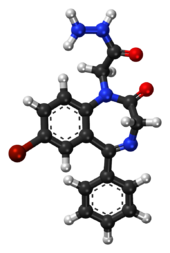Gidazepam
Appearance
 | |
 | |
| Clinical data | |
|---|---|
| Trade names | Gidazepam IC |
| Pregnancy category |
|
| Routes of administration | Oral |
| ATC code | |
| Legal status | |
| Legal status |
|
| Pharmacokinetic data | |
| Bioavailability | ? |
| Metabolism | Hepatic |
| Elimination half-life | 86,7 hours |
| Excretion | Renal |
| Identifiers | |
| |
| CAS Number | |
| PubChem CID | |
| DrugBank | |
| ChemSpider | |
| UNII | |
| CompTox Dashboard (EPA) | |
| Chemical and physical data | |
| Formula | C17H15BrN4O2 |
| Molar mass | 387.2 g·mol−1 |
| 3D model (JSmol) | |
| |
| |
| | |
Gidazepam, also known as hydazepam or hidazepam,[1] is a drug which is an atypical benzodiazepine derivative, developed in the Soviet Union.[2][3] It is a selectively anxiolytic benzodiazepine.[4] It also has therapeutic value in the management of certain cardiovascular disorders.[5][6][7][8][9]
Gidazepam is a prodrug for its active metabolite 7-bromo-5-phenyl-1,2-dihydro-3H-1,4-benzodiazepine-2-one (desalkylgidazepam or bromo-nordazepam).[10][11] It is used as an antianxiety drug. Its anxiolytic effects can take several hours to manifest after dosing however, as it is the active metabolite which primarily gives the anxiolytic effects.[12]

See also
- Phenazepam—another benzodiazepine widely used in Russia and other CIS countries
- Cinazepam
- Cloxazolam
References
- ^ Library of Congress (2006). Library of Congress Subject Headings. Library of Congress. pp. 3300–.
- ^ Spasennikov, BA; Spasennikova, MG (Sep 1991). "The new Soviet tranquilizer--gidazepam". Fel'dsher i akusherka. 56 (9): 35–7. ISSN 0014-9772. PMID 1684941.
- ^ Neznamov, GG; Koshelev, VV; Voronina, TA; Trofimov, SS (Mar 2002). "Experimental and clinical rationale for complex treatment of mental disorders in clean-up workers of the Chernobyl nuclear plant accident". Eksperimental'naia i klinicheskaia farmakologiia. 65 (2): 12–6. ISSN 0869-2092. PMID 12109283.
- ^ Korkhov, VM; Tkachuk, NA; Makan, SY; Pavlovsky, VI; Andronati, SA (Feb 2002). "Affinities of gidazepam and its analogs for mitochondrial benzodiazepine receptors". Journal of receptor and signal transduction research. 22 (1–4): 411–20. doi:10.1081/RRS-120014610. ISSN 1079-9893. PMID 12503630.
- ^ Morozov, IS; Barchukov, VG; Neznamov, GG (Jan 1998). "The effect of gidazepam on the cardiovascular system function in patients with neurotic reactions and in healthy subjects under aggravated conditions". Eksperimental'naia i klinicheskaia farmakologiia. 61 (1): 30–2. ISSN 0869-2092. PMID 9575408.
- ^ Petrova, TR; Tatarkin, AN (1994). "The neuroregulatory modulation of the hemodynamic reactions to physical loading in patients with cardiac arrhythmias". Terapevticheskii arkhiv. 66 (9): 65–8. ISSN 0040-3660. PMID 7992218.
- ^ Skibitskiĭ, VV; Kanorskiĭ, SG (Sep 1993). "New pharmacodynamic effects of gidazepam and befol in patients with cardiac arrhythmias". Eksperimental'naia i klinicheskaia farmakologiia. 56 (5): 23–7. ISSN 0869-2092. PMID 7906171.
- ^ Skibitskiĭ, VV; Petrova, TR; Kanorskiĭ, SG (Jun 1992). "Comparative analysis of antiarrhythmic action and electrophysiological effects of a new benzodiazepine derivative gidazepam and ethacizin in arrhythmias of various genesis". Kardiologiia. 32 (6): 35–7. ISSN 0022-9040. PMID 1405290.
- ^ Meerson, FZ; Skibitskiĭ, VV (Apr 1992). "Comparative anti-arrhythmia effectiveness of activators of body stress-limiting systems in patients with arrhythmia". Kardiologiia. 32 (4): 25–30. ISSN 0022-9040. PMID 1328745.
- ^ Andronati, SA; Zin'kovskiĭ, VG; Totrova, MIu; Golovenko, NIa; Stankevich, EA; Zhuk, OV (Jan 1992). "Biokinetics of a new prodrug gidazepam and its metabolite". Biulleten' eksperimental'noi biologii i meditsiny. 113 (1): 45–7. ISSN 0365-9615. PMID 1356504.
- ^ Kolyvanov, GB; Zherdev, VP; Chirkov, AM; Otabekova, SG; Litvin, AA (May 1993). "Gidazepam biotransformation and pharmacokinetics in different species of animals and man". Eksperimental'naia i klinicheskaia farmakologiia. 56 (3): 48–50. ISSN 0869-2092. PMID 8106054.
- ^ Zherdev, VP; Neznamov, GG; Kolyvanov, GB; Litvin, AA; Otabekova, SG (May 1993). "The pharmacokinetic aspects of the clinical action of gidazepam". Eksperimental'naia i klinicheskaia farmakologiia. 56 (3): 50–2. ISSN 0869-2092. PMID 8106055.
